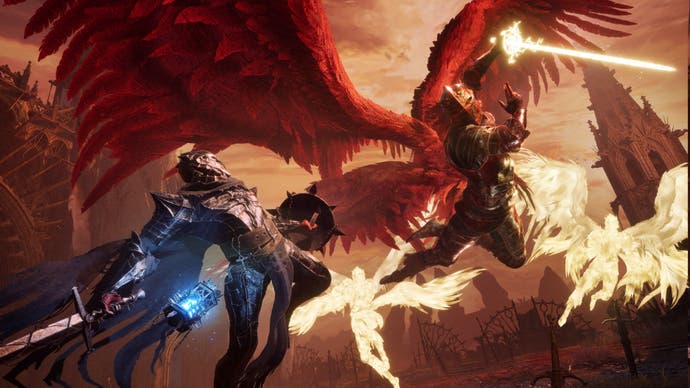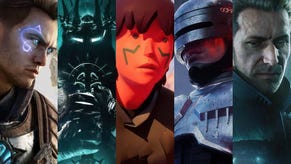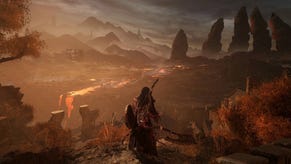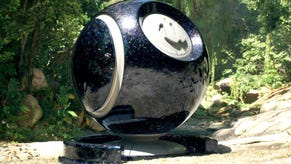In a post-Elden Ring world, does Lords of the Fallen have what it takes?
Hands on with FromSoft's latest challenger.
It's impossible not to define Lords of the Fallen in FromSoftware's terms. With its capital-D Dark Fantasy world and its dodge rolls and healing flasks and monster factory characters, Hexworks - a collective of two studios in Barcelona and Bucharest that's still a part of the same CI Games that co-developed the first Lords of the Fallen, back in 2014 - has defined itself into a certain class, a specifically challenging weight category and, in the process, squared up to one of video games' all-time super heavyweight champions of the world. I'm not sure they've picked a fair fight.
I've played a couple of hours of new Lords of the Fallen and crucially, I can tell you it's: good. If you've played a Soulslike before - or as Hexworks wisely describes the genre, which extends to Nioh, The Surge and the rest, tactical action-RPGs - it'll be immediately familiar. You can create a character from one of several preset classes, ranging from glass cannon mages to sword-and-shield warriors, with some more lore-y archetypes in between with a little clan-based backstory behind them: a raven-like archer, a brawler with a twist of wolves.
You'll put points into stats as you level up - which you do at Vestiges, Lords of the Fallen's take on bonfires, that also act as fast travel points and places to rest and heal up. You'll do a little dodge or a big dodge, conserve your stamina, create a fraction of free time to swig your healing brew, maybe fire off a perfect parry. There will be mini-bosses, multi-stage, transformative boss fights, and sneaky little scumbags poking you in the back from their hiding place behind doors. The problem is "good" might not be good enough.
Lords of the Fallen is not a straight rip of Dark Souls or Demon Souls or the rest, mind. Hexworks will argue - justifiably, I should say - that they have plenty more inspirations to call on. "Nioh, Sekiro, Final Fantasy 7 Remake," were a few thrown out by executive producer Saul Gascon as games with specific moments of inspiration for Hexworks, along with Soul Reaver, classic Zelda on the NES, French contemporary artists, HR Geiger, Polish comic book artist Grzegorz Rosiński, even Constantine or certain episodes of Demon Slayer for its world. And of course there's Lords of the Fallen's big twist.
If you read our first, extensive hands-off preview and interview for Lords of the Fallen, you'll know it also has Umbral, an entire, hidden, ghostly blue second layer to its world. Your character, being close to literally passed the torch in Lords of the Fallen's opening cutscene, picks up the blue flame from a fallen knight to continue the fight with the Lightreaper, a Witch King-alike riding a Nazgûl-alike with a Mouth of Sauron-like face, set up as the game's big bad. Naturally, this lanturn has powers: raise it and you'll reveal a small portion of the Umbral world in front of you. Suddenly, a locked door's blockage is revealed, a portcullis is removed, or just loads of skulls and rib cages and assorted cartilage appear on stuff.
I'm underselling it, because the Umbral world is magic: transport yourself there completely and you'll be able to solve environmental puzzles, traversing the otherwise untraversable while under some form of time pressure from a big gaping eye and a metre that gradually fills, throwing ever more low-damage enemies at you until you're overwhelmed. Work your way to a specific totem and interact with it and you'll return to the real world, your path's blockage unblocked, or uncrossable path crossed.

The bigger twist is that the Umbral world is where you'll go when you die in the real one - Souls Die Twice here in Lords of the Fallen too - born again in the same place with a second life, and a chance to return to the normal one if you find another totem. You can also use this world to your advantage: you'll find better items here, and can farm some grisly wall pustules for grey health - a placeholder on your health bar which, for each hit you land on an enemy, gradually restores your actual health, or is obliterated if you take a single hit yourself.
Like any good Soulslike, Lords of the Fallen's entire opening area serves as a tutorial for this mechanic and its many others. I worked my way through the Accursed Grove, using a map made purely of fragmented sketches - clock tower, angry lady, big bell, etc. - for a fight in some smelly swamp (obligatory) with the Lightbringer, which gives room for another callout to Sekiro. Yes, you can beat the game's boss in this very first fight, Cezar Virtosu, Hexworks' creative director confirmed to me. It will be almost impossible, naturally - and unlike Sekiro it won't effectively end the game there. "It does change the quests," Virtosu said, "and you'll have a reward cinematic if you beat him," Gascon confirmed.
Beyond that, a ramshackle village up to a towering castle, and more of a proper boss in Pieta, a corrupted angel-like enemy with a fairly traditional three phases. It took maybe half a dozen attempts to bring her down, and the impression so far is Lords of the Fallen is marginally easier than a FromSoft equivalent - I'd say aiming for perfect parries is not only viable but advisable, even for average players. Virtosu and Gascon defined this in terms of accessibility, or approachability, with the option to bring in a friend for co-op available at any time, and the Iron Wayfarer, a mysterious in-game character, at hand to be used as a distraction in battle if I wanted the option. Emphasis was placed on Lords of the Fallen "modernising" the series in this way, but most of all in how the high fantasy of the original becomes dark fantasy here.

Virtosu cited another range of inspirations as the reasoning here, from Game of Thrones - which "showed unfettered violence and everything with negative emotions" - to how we've shifted from orcs and elves and Space Marines, as he put it, to "more grounded, muddy, grey questions, no heroes, uncaring worlds, unravelling, Lovecraftian, where divinity is not a God that comes with magic but a creature." All this "soup," of darker tone became Hexworks own interpretation of what "modernising" the original meant.
Back to Pieta, and this battle was intended as a classic use-everything-you've-learned test to mark the end of a lengthy tutorial section, Hexworks told me - but in a way it functioned as a sign of where Lords of the Fallen hits some of its limits, the greatest of which being its lack of clarity. Lords of the Fallen, at least in my early time with it, seems to have too many abilities for a controller to handle. "Try throwing bombs when she's flying," was one piece of advice for Pieta - only doing so is hardly boss fight-friendly. You'll need to switch to ranged mode with a shoulder button, switch what you're throwing and then select it with a face button, then hold a different button to either manually aim it or throw it to your locked-on target - a multi-fingered, multi-stage combination of button presses for what was effectively a little chip damage, during a split-second better used for a more impactful gulp of healing potion.
There are similar complexities around using Umbral to your advantage. Against some enemies, in the real world, you can use Soulflay, a kind of short-range whipping attack with a magic beam that drags a soul out of an enemy's body for you to wail on quickly, causing hefty bonus damage and potentially knocking them down. But the enemies you can and can't use this on aren't clear - turns out Pieta is immune for… unknown story reasons - while within minutes of finishing my playthrough I couldn't tell you whether Soulflay is usable just in the real world or also Umbral. One of them grants you temporary health like the wall pustules; in the Umbral world it can also be used to pull platforms towards you; in the Umbral world you need to use a different Soul-noun to syphon those pustules but in the real world that Soul-noun can syphon hidden Umbral ghouls that give real-world enemies immunity. (Deep breath.)
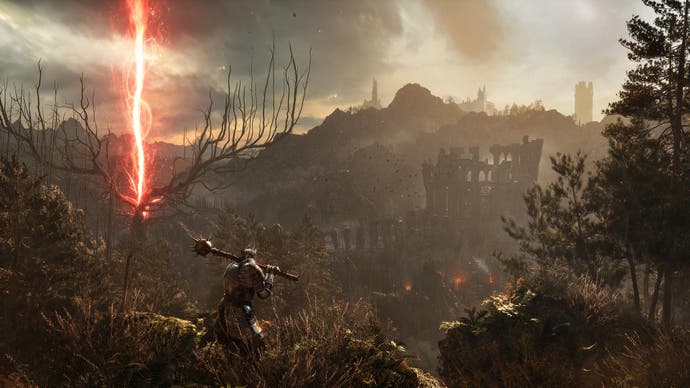
There are Star Wars: Jedi-like Force Echoes (Stigmas here) which you can interact with in the real world to go to the Umbral to see a bit of lore about some people dying, but which also triggers a load of enemies attacking you that didn't seem to be worth the risk. And a couple of issues with readability also came up - one notoriously near-invisible ladder at a dead-end stumped everyone, with Hexworks already knowing it needed a tweak, but others too. Early on, you can hold up your lantern - creating a temporary view to Umbral - to walk through a barred gate that disappears in the Umbral world without fully going to the Umbral world and having to go all the way to a totem to return. But then a little later, a toxic pool of water disappeared around me when I held up my lantern, but wading into it killed me outright. Add that to a couple moments spent running in circles waving my lantern at things looking for the way forward and it does seem like a minor concern to think about before launch.
The big mitigating factor here is we're still several months away from that launch, and Hexworks largely knows the work it has to do to tidy things up. There's also the all-important preview factor: Lords of the Fallen throws a tidal wave of systems, stats pages, items and mechanics at you in its first couple of hours, and while stopping around two hours in can leave you with a sense of drowning in a sea of proper nouns, the likelihood is much of these hold-this-cycle-these-tap-that commands will become closer to second nature in due time. For now, they feel like my attempts to recreate those viral Zelda: Tears of the Kingdom combat videos, where players seem to gain an anime protagonist's powers to slow time and space indefinitely and combo together one of every item and attack in the game (attempts that do not succeed).
In Lords of the Fallen's case, we are very much in wait-and-see territory. Its early stages suggest, if nothing else, competence. There's some wonderfully grim atmosphere, rich environmental detail, and potential that I feel I barely touched in its environmental puzzling and branching, spiralling paths through secret routes and hidden passages. I suspect it'll come together quite nicely, the complexities evolving into nuance with time. But those bits of tuning up are all going to be necessary come October - Hexworks has signed up for a title bout, don't forget.
